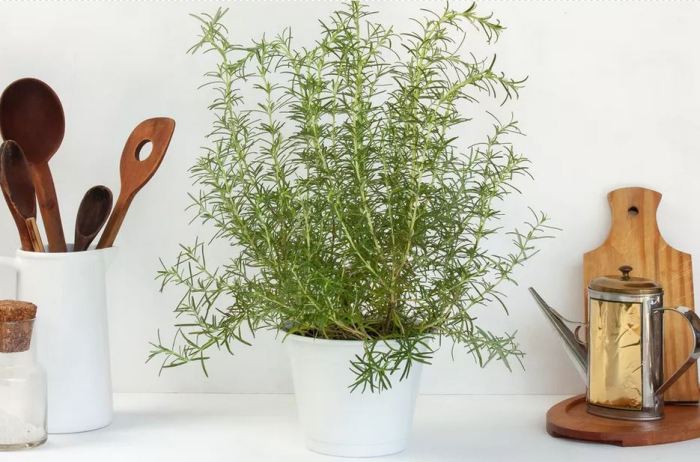7 secrets for planting and cultivating rosemary in pots and your garden
Rosemary is one of the most useful aromatic plants that we plant in the garden and is an excellent plant choice for creating a rock garden. We can also grow rosemary in a pot on our balcony, as it adapts easily and does not have significant care requirements. Perennial shrub, multi-branched and densely leafed, with needle-like leaves, the rosemary grows from one to two meters in height and shows wonderful fragrant flowers with a light blue color during spring and summer. There are many varieties of rosemary, wild and cultivated to plant, while of particular interest is the creeping rosemary that grows on sloping branches and can be used in hanging baskets or to cover vertically a stone or wooden fence. In addition to the beauty it gives to our garden, rosemary has many uses in cooking and in the cosmetics and pharmaceutical industries, thanks to the unique properties of its essential oil. Let’s look at the most important tips for caring for the rosemary and how we can keep it wonderful and healthy in our garden.

Basil: a wonderful plant with a fantastic aroma and beneficial properties in your pot and garden
Where do we plant rosemary and where does it grow best?
Rosemary grows easily and is grown in areas with a Mediterranean climate and a sunny dry thermal environment. If planted in a shady environment, rosemary shows reduced growth and less flowering. It is resistant to frost and low rainfall, after all we can find rosemary native to places with an altitude of 600 meters. It can adapt to most soil types even in dry barren soils and thrives best in light soils with good drainage and neutral pH.
How often does rosemary need watering and fertilizing?
Rosemary has low requirements for watering and fertilizing. Initially, in the first year of life, after transplanting, we do small and frequent watering to root better. Then, due to the strong and extensive root system that it develops, we water once a week, even in the summer months. With regard to rosemary fertilization, the incorporation of a small amount of complete organic fertilizer in early spring is appropriate to have rich growth and flowering.

Chamomile, learn how to grow it in a pot or in your garden
What diseases and insects infect rosemary?
In conditions of high humidity and poor ventilation, rosemary can be infected with various fungal diseases that infect the root, as well as foliage. To protect the rosemary, we can spray with an ecological sulfur solution or an improvised baking soda solution that we make by dissolving 1 tablespoon of baking soda and 2 tablespoons of olive oil in 2 liters of water. To protect against the insect of the meligra, the floury and the beetle of rosemary (Chrysolina americana), we spray with an improvised solution of grated green soap that we make by dissolving 20 grams of grated green soap and 5ml of alcohol in 1 liter of water. Alternatively, we use a natural pyrethrin preparation supplied by agricultural stores.
What season and how is the rosemary pruned?
Rosemary is pruned in late winter or early autumn after the end of flowering. We lightly prune the rosemary every year, removing dry and weak shoots, while at the same time limiting its growth by pruning the top vegetation. We can also make lightly crafted scissors and give different shapes to our rosemary. Finally, every 3-4 years, we can do a strict pruning of the rosemary, cutting its branches from a low height of 10-15 cm from the ground to renew its woody shoots.

How do we make new rosemary plants?
Rosemary is propagated by cuttings, seeds and twigs. For rosemary cuttings, in the spring we cut shoots from the top of the plant to a length of 10 cm, from which we remove the leaves of the base. Then, we place the cuttings in a substrate of manure, soil and sand in a ratio of 1: 1: 1, in a shady wet environment. After three or four months, our graft will take root and we can transplant the rosemary to a permanent place, in the garden or in a pot.
What are the uses of rosemary?
Rosemary is widely used in cooking, to flavor various dishes and especially in fish recipes. Rosemary essential oil is used in aromatherapy and soap making. In medicine, rosemary has a beneficial effect against coughs, asthma, rheumatism, fatigue and nervous headaches. Rosemary is also considered one of the most effective insect repellents along with lavender and basil. In ecological agriculture, rosemary in co-cultivation with cabbage, broccoli and cauliflower can prevent the caterpillar that infects them.
Dandelions – not an annoying weed, but a medicinal plant in your garden
And one last secret about rosemary
The Latin name of the rosemary, Rosmarinus, is a compound of the words: ros, meaning cool, and marinus, meaning sea, and suggests that rosemary may grow in coastal areas.

















Images via: Pinterest







2 comments
[…] Cherry tomatoes, peppers or cucumbers to aromatic plants such as rosemary, mint, all can be grown in tall vegetable […]
[…] 7 secrets for planting and cultivating rosemary in pots and your garden […]